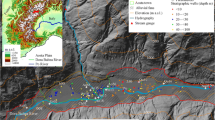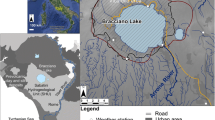Abstract
Modelling groundwater and surface water is important for integrated water resources management, especially when interaction between the river and the aquifer is high. A transient groundwater and surface water flow model was built for Ruataniwha basin, New Zealand. The model covers a long-time period; starting in 1990, when water resources development in the area started, to present date. For a better resolution, the simulation period was divided into 59 stress periods, and each stress period was divided to 10 time steps. The model uses data obtained from surface water, and groundwater collected over the last 20 years. Rivers and streams were divided into 28 segments and flow and streambed data at the beginning and end of each segment was used. Parameter estimation and optimisation ‘PEST’ was used for automatic calibration of hydraulic conductivity, groundwater recharge and storativity; whereas riverbed conductance was manually calibrated. Model results show that the rivers gain from the aquifer considerably more than the river losses. The cumulative groundwater abstraction over the last 20 years is approximately 210 million m3. This amount is very low compared to other water budget components; however, the effect of groundwater abstraction on storage is significant. Based on the results of this study, it was found that the loss of storage over the last 20 years is more than 66 million m3. Results also reveal that the effect of groundwater abstraction on rivers and springs flow is significant. The rivers gain from the groundwater system, and the springs flow have been decreasing.







Similar content being viewed by others
References
Baalousha H (2008) Water balance model for Ruataniwha Basin. Hawke’s Bay Regional Council. Technical report EMT 08/05
Baalousha H (2009) Ruataniwha Basin modelling. A steady state groundwater flow model. Hawke’s Bay Regional Council. Technical report EMT 09/06
Butler J, Zlotlink V, Tsou M (2001) Drawdown and stream depletion produced by pumping in the vicinity of a partial penetrating stream. Ground Water 39(5):651–659
Doherty J (2009) PEST: model-independent parameter estimation. Watermark Numerical Computing, Brisbane. http://www.sspa.com/pest. Accessed 15 May 2010
Dravid D, Cameron S (1997) Ruataniwha plains groundwater research 1996–1998. 1996/97 Interim report. Technical report no. EMI 9704. Hawke’s Bay Regional Council
Fitts C (2002) Groundwater science. Elsevier, USA, p 452
Fox GA, Duchateau P, Durnford DS (2002) Analytical model for aquifer response incorporation distributed stream leakage. Ground Water 40(4):378–384
Francis D (2001) Subsurface geology of the Ruataniwha Plains and relation to hydrology. Technical report. Geological Research Ltd, Lower Hutt
Freeze A, Cherry J (1979) Groundwater. Prentice-Hall, NJ, p 604
Glover RE, Balmer GG (1954) River depletion resulting from pumping a well near a river. Trans Am Geophys Union 35(3):368–470
Hantush MS (1965) Wells near streams with semi previous beds. J Geophys Res 70(12):2829–2838
Hawke’s Bay Regional Council (2003) Ruataniwha Plains water resources investigations. ISBN 1-877174-49
Hunt B (1999) Unsteady stream depletion from ground water pumping. Ground Water 37(1):98–102
Hunt B (2008) Stream depletion for streams and aquifers with finite widths. J Hydrol Eng 13(2):80–89
McDonald MG, Harbaugh AW (1988) A modular three-dimensional finite-difference ground-water flow model. US geological survey techniques of water resources investigations report book 6, chap A1, p 528
Murray DL (2002a) Modelling Ruataniwha Plains groundwater. Report prepared for Hawke’s Bay Regional Council
Murray DL (2002b) Recalibration of the Ruataniwha Plains groundwater model. Report prepared for Hawke’s Bay Regional Council
Pattle Delamore Partners (1999) Ruataniwha Plains conceptual hydrogeological model. Technical report
Phreatos Groundwater Research and Consulting (2003) Ruataniwha Plains groundwater model. Phase 2 visual MODFLOW version. Model refinement and revised water balance calibration, prepared for Hawke’s Bay Regional Council
Rushton K (2007) Representation in regional models of saturated river–aquifer interaction for gaining/losing rivers. J Hydrol 334(1–2):262–281
Schlumberger Water Services (2008) Visual MODFLOW premium 4.3. User’s manual
Sophocleous M, Koussis A, Martin JL, Perkins SP (1995) Evaluation of a simplified stream-aquifer depletion models for water rights administration. Ground Water 33(4):579–588
Spalding CP, Khaleel R (1991) An evaluation of analytical solutions to estimate drawdown and stream depletion by wells. Water Resour Res 27(4):597–609
Theis C (1935) The relation between the lowering of the piezometric surface and the rate and duration of discharge of a well using ground-water storage. EOS T AM Geophys UN 16:519–524
Author information
Authors and Affiliations
Corresponding author
Electronic supplementary material
Below is the link to the electronic supplementary material.
Rights and permissions
About this article
Cite this article
Baalousha, H.M. Modelling surface–groundwater interaction in the Ruataniwha basin, Hawke’s Bay, New Zealand. Environ Earth Sci 66, 285–294 (2012). https://doi.org/10.1007/s12665-011-1238-y
Received:
Accepted:
Published:
Issue Date:
DOI: https://doi.org/10.1007/s12665-011-1238-y




